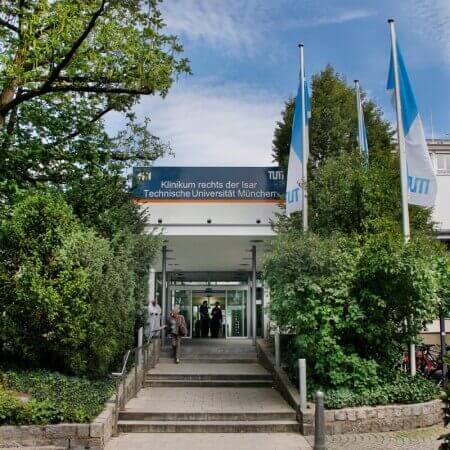Brain Cavernoma — Platinum Coils Embolization (coiling): treatment in the Best Hospitals in the World
Treatment prices are regulated by national law of the corresponding countries, but can also include additional hospital coefficients. In order to receive the individual cost calculation, please send us the request and medical records.

Department of Interventional Neuroradiology
The Department of Interventional Neuroradiology offers the full range of services in the areas of its specialization. The medical facility provides imaging diagnostics and low-traumatic image-guided interventional treatment of nervous system diseases. The department's specialists have rich experience and exceptional professional skills in the field of interventional procedures for acute and chronic vascular diseases, such as ischemic strokes, brain hemorrhages, cerebral artery stenosis, brain aneurysms, and vascular malformations. The department's neuroradiologists cooperate closely with neurologists and neurosurgeons so that each patient receives an optimal treatment regimen based on the expert opinions of the specialists. The department's medical team has state-of-the-art computed tomography (CT), magnetic resonance imaging (MRI), and MR angiography systems that are actively used for diagnosing patients and therapeutic procedures. Medical care is provided in compliance with current clinical protocols. The department also offers many outpatient medical services, which is an advantage for many patients.




Department of Adult and Pediatric Diagnostic, Interventional Neuroradiology
The Department of Adult and Pediatric Diagnostic, Interventional Neuroradiology offers the widest range of services for the diagnostics and treatment of diseases of the brain, spinal cord and peripheral nerves using the advanced imaging systems. The department is equipped with modern technical devices, including 64-slice CT scanner, 1,5 and 3,0 Tesla MRI, biplane angiography system with 3D imaging of the blood vessels and bone structures, system for myelography of the entire spine and ultrasound scanners. All these devices are used not only for the diagnostics, but also for interventional procedures to treat obstructions, stenoses and other pathological vascular lesions in the head, neck and spine. The most popular interventional therapeutic procedures include clipping and coiling of cerebral vascular aneurysms, as well as cerebral vascular malformations. The department's doctors cooperate closely with specialists in the field of neurosurgery, neurology and pediatric neurology. Such an approach guarantees the patient a comprehensive assessment of the state of the nervous system and a favourable treatment outcome.





Department of Interventional Radiology
The Department of Interventional Radiology offers the full range of imaging examinations, as well as innovative image-guided minimally invasive techniques for the treatment of tumors, vascular diseases and internal pathologies (for example, CT, MRI, PET-CT, SPECT). The department's doctors have deep knowledge and colossal experience in the field of interventional radiological methods of treatment, which represent an excellent alternative to open surgical interventions. Despite the high level of technical equipment and the presence of advanced computerized systems, the focus is always on the person with his individual needs. Compliance with current clinical protocols and high professionalism of the department's specialists contribute to the successful clinical practice, as well as the reputability of the department among the best medical facilities of this kind in Germany.



A cavernous malformation is a disease of the vessels of the spinal cord and brain, in which vascular cavities filled with blood are formed. Cavernomas are divided into many compartments and pose a life threat, as they can cause cerebral hemorrhage if ruptured.
Overview
Most often, the cavernous malformation is found in the cerebral hemispheres. Brain cavernomas may have a diameter from a few millimeters to 2-5 centimeters.
Often, a brain cavernoma causes no symptoms and remains unnoticed. Bleeding caused by cavernous malformation often leads to the development of first clinical symptoms. Depending on the size and location of the brain cavernoma, bleeding can cause brain damage and even death. However, bleeding from cavernomas is often less severe than bleeding from aneurysms or AVMs. Symptoms of a ruptured cavernoma are similar to aneurysms and often manifest suddenly and include severe headaches that do not resemble general headaches, nausea, and vomiting, sensitivity to light, loss of consciousness and seizures.
Genetic predisposition is supposed to be the main cause of the cavernous malformations. It has been noticed that negative environmental factors also play a role in their development. Often, vascular pathology occurs in the cerebral hemispheres in the subcortical zone, less often – in the cerebellum and deep brain structures.
The patient can be unaware of the presence of a brain cavernoma for many years, since the symptoms are sometimes absent or not significant. Cavernous malformation is usually detected accidentally, during examination for another reason. If vital parts of the brain are affected, the following symptoms may occur: nausea, headache, vomiting, impaired speech and vision, difficulty swallowing, cramps, and numbness of body parts.
If the brain cavernoma is large, it begins to put pressure on parts of the brain and the disease is accompanied by a pronounced clinical picture. The most dangerous complication is internal cerebral hemorrhage due to the rupture of the vessel walls. In such cases the patient requires emergency medical services.
Diagnostics
It is not so easy to detect a brain cavernoma, therefore, the most informative and modern diagnostic methods using the latest equipment are needed. In the best hospitals in the world, it is not difficult to diagnose brain cavernoma.
Magnetic resonance imaging is the most informative method for detecting even the smallest brain cavernomas. Pathological accumulations of blood vessels are visible on the obtained images of deep and superficial structures of the brain and spinal cord. To confirm the diagnosis, a contrast agent is often used, which is injected into the bloodstream that supplies the area of formation.
Computed tomography is also often performed using a contrast agent in order to visualize pathology better. The method allows detecting single and multiple malformations, obtaining comprehensive information about the brain structures, and revealing hemorrhages.
The electroencephalogram (EEG) makes it possible to study the biopotential of the brain and determine indirectly the presence of neoplasms of various sizes in certain areas. When a brain cavernoma is detected, the electrical signal from the structures of the brain changes.
For the detection of brain cavernoma, angiography is used as an additional method. It is informative for differential diagnosis, as it may exclude the presence of aneurysm and other disorders. Sometimes tractography is used for a detailed study of the brain cavernoma located deep in the brain structures, followed by the surgical treatment.
Treatment options
For the treatment of brain cavernomas minimally invasive procedures are mainly used to achieve excellent results and avoid complications. After such procedures the recovery period is minimal.
To switch off the pathological focus from the cerebral circulation, endovascular embolization is performed. To block the vessels of the brain cavernoma, a special drug that glues the vessel walls or platinum coils are used. In both cases medical materials are introduced inside a cavernoma using a catheter, which is placed into the femoral artery and moved to the malformation. A few days after the embolization procedure, blood stops flowing into the brain cavernoma.
The main task of the embolization procedure is to cut off the dangerous area from the systemic circulation. During the embolization procedure, doctors insert the vascular catheter through a puncture in the femoral artery, move it along the patient's vessels and then put platinum coils into the cavity of brain cavernoma. This creates the necessary conditions for the subsequent thrombosis of the dangerous area. The blood flow no longer creates critical pressure, and the risk of rupture disappears.
The most important advantage of the embolization is the possibility of treating brain cavernomas in the hard-to-reach brain regions, or even simply avoiding the invasive direct surgical intervention. It is also indicated for patients in the acute period of hemorrhage, those who are unable to tolerate open surgery.
Where can I undergo platinum coils embolization (coiling) abroad?
Health tourism is becoming more and more popular these days, as medicine abroad often ensures a much better quality of platinum coils embolization (coiling).
The following hospitals show the best success rates in platinum coils embolization (coiling):
- University Hospital Saarland Homburg, Germany
- HELIOS University Hospital Wuppertal, Germany
- University Hospital Rechts der Isar Munich, Germany
- Vivantes Neukölln Hospital Berlin, Germany
- University Hospital Ulm, Germany
You can find more information about the hospitals on the Booking Health website.
The cost of treatment abroad
The prices in hospitals listed on the Booking Health website are relatively low. With Booking Health, you can undergo platinum coils embolization (coiling) at an affordable price.
The cost of treatment varies, as the price depends on the hospital, the specifics of the disease, and the complexity of its treatment.
The cost of treatment with platinum coils embolization (coiling) in Germany is 17,161-34,082 EUR.
You might want to consider the cost of possible additional procedures and follow-up care. Therefore, the ultimate cost of treatment may differ from the initial price.
To make sure that the overall cost of treatment is suitable for you, contact us by leaving the request on the Booking Health website.
How can I undergo platinum coils embolization (coiling) abroad?
It is not easy to self-organize any treatment abroad. It requires certain knowledge and expertise. Thus, it is safer, easier, and less stressful to use the services of a medical tourism agency.
As the largest and most transparent medical tourism agency in the world, Booking Health has up-to-date information about platinum coils embolization (coiling) in the best hospitals. We will help you select the right clinic taking into account your wishes for treatment.
We want to help you and take on all the troubles. You can be free of unnecessary stress, while Booking Health takes care of all organizational issues regarding the treatment. Our services are aimed at undergoing platinum coils embolization (coiling) safely and successfully.
Medical tourism can be easy! All you need to do is to leave a request on the Booking Health website, and our manager will contact you shortly.

